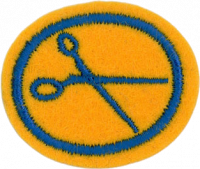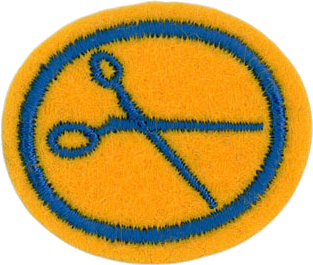Difference between revisions of "AY Honors/Dressmaking/Answer Key/es"
From Pathfinder Wiki
< AY Honors | DressmakingAY Honors/Dressmaking/Answer Key/es
(Created page with "{{clear}}") |
|||
| (3 intermediate revisions by the same user not shown) | |||
| Line 1: | Line 1: | ||
| − | + | {{HonorSubpage}} | |
| − | |||
| − | {{ | ||
| − | |||
| − | |||
| − | |||
| − | |||
| − | |||
| − | |||
| − | |||
| − | }} | ||
| − | |||
| − | |||
| − | |||
<section begin="Body" /> | <section begin="Body" /> | ||
{{ansreq|page={{#titleparts:{{PAGENAME}}|2|1}}|num=1}} | {{ansreq|page={{#titleparts:{{PAGENAME}}|2|1}}|num=1}} | ||
| − | <noinclude> | + | <noinclude></noinclude> |
| − | {{ | + | <!-- 1. Tener y repasar la especialidad de Costura básica. --> |
| + | {{honor_prerequisite|honor=Basic Sewing|displayname=Costura básica}} | ||
<noinclude></noinclude> | <noinclude></noinclude> | ||
| Line 22: | Line 10: | ||
{{ansreq|page={{#titleparts:{{PAGENAME}}|2|1}}|num=2}} | {{ansreq|page={{#titleparts:{{PAGENAME}}|2|1}}|num=2}} | ||
<noinclude></noinclude> | <noinclude></noinclude> | ||
| − | <!-- 2. | + | <!-- 2. Tener un costurero para sus suministros de costura. Incluir un alfiletero, cinta métrica, alfileres, agujas, hilo, tijeras, medidor de costura y descosedor. --> |
| − | |||
<noinclude></noinclude> | <noinclude></noinclude> | ||
| Line 29: | Line 16: | ||
{{ansreq|page={{#titleparts:{{PAGENAME}}|2|1}}|num=3}} | {{ansreq|page={{#titleparts:{{PAGENAME}}|2|1}}|num=3}} | ||
<noinclude></noinclude> | <noinclude></noinclude> | ||
| − | <!-- 3. | + | <!-- 3. Saber cómo y cuándo: Hilvanar, sobre hilar, serpentear (zigzag) y dobladilla ciego. --> |
| − | |||
| − | |||
| − | |||
{{clear}} | {{clear}} | ||
| Line 56: | Line 40: | ||
{{ansreq|page={{#titleparts:{{PAGENAME}}|2|1}}|num=4}} | {{ansreq|page={{#titleparts:{{PAGENAME}}|2|1}}|num=4}} | ||
<noinclude></noinclude> | <noinclude></noinclude> | ||
| − | <!-- 4. | + | <!-- 4. Identificar (a) cinco telas naturales como el algodón, lino, lana, seda, etc. y (b) tela sintéticas como el rayón, nylon, dacrón y poliéster. --> |
| − | |||
{{clear}} | {{clear}} | ||
| Line 65: | Line 48: | ||
{{ansreq|page={{#titleparts:{{PAGENAME}}|2|1}}|num=5}} | {{ansreq|page={{#titleparts:{{PAGENAME}}|2|1}}|num=5}} | ||
<noinclude></noinclude> | <noinclude></noinclude> | ||
| − | <!-- 5. | + | <!-- 5. Demostrar la manera de enderezar la tela antes de su uso. --> |
| − | |||
| − | {{clear}} | + | {{clear}} |
{{clear}} | {{clear}} | ||
| Line 78: | Line 60: | ||
{{ansreq|page={{#titleparts:{{PAGENAME}}|2|1}}|num=6}} | {{ansreq|page={{#titleparts:{{PAGENAME}}|2|1}}|num=6}} | ||
<noinclude></noinclude> | <noinclude></noinclude> | ||
| − | <!-- 6. | + | <!-- 6. Elegir un modelo para un artículo como una camisa, blusa, falda o delantal de tienda. Colocar correctamente el patrón en la tela, cortar y coser el artículo para su finalización. --> |
| − | |||
{{clear}} | {{clear}} | ||
| − | {{clear}} | + | {{clear}} |
{{clear}} | {{clear}} | ||
| Line 96: | Line 77: | ||
{{clear}} | {{clear}} | ||
| − | |||
<noinclude></noinclude> | <noinclude></noinclude> | ||
| − | + | {{CloseHonorPage}} | |
Latest revision as of 00:26, 26 July 2022
Corte y confección
Nivel de destreza
1
Año
1929
Version
20.05.2024
Autoridad de aprobación
Asociación General
1
Tener y repasar la especialidad de Costura básica.
Para consejos e instrucciones, véase Costura básica.
2
Tener un costurero para sus suministros de costura. Incluir un alfiletero, cinta métrica, alfileres, agujas, hilo, tijeras, medidor de costura y descosedor.
3
Saber cómo y cuándo: Hilvanar, sobre hilar, serpentear (zigzag) y dobladilla ciego.
4
Identificar (a) cinco telas naturales como el algodón, lino, lana, seda, etc. y (b) tela sintéticas como el rayón, nylon, dacrón y poliéster.
5
Demostrar la manera de enderezar la tela antes de su uso.
6
Elegir un modelo para un artículo como una camisa, blusa, falda o delantal de tienda. Colocar correctamente el patrón en la tela, cortar y coser el artículo para su finalización.
Referencias


